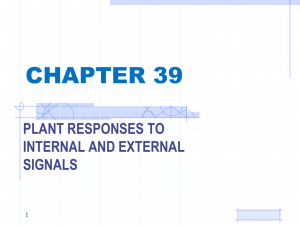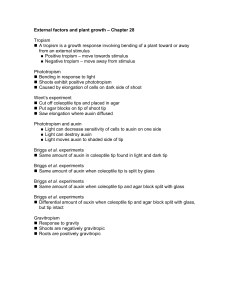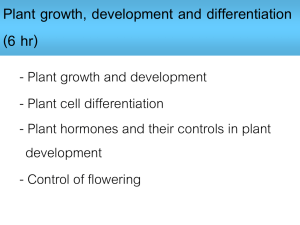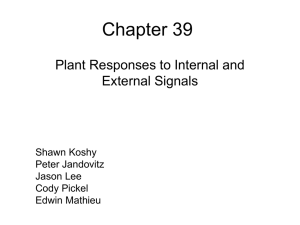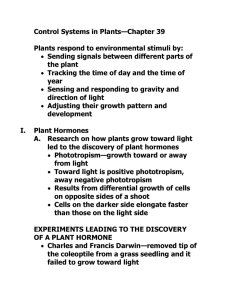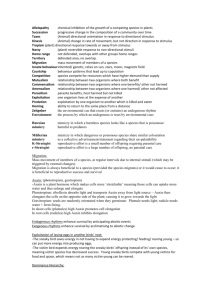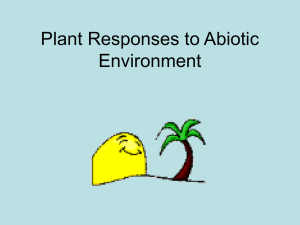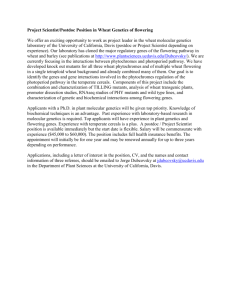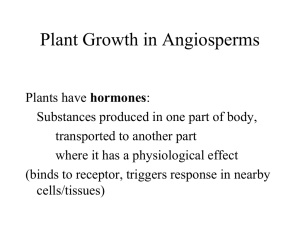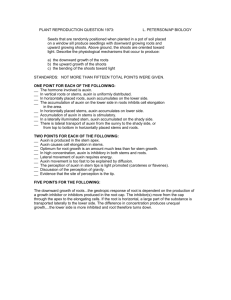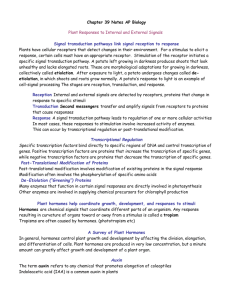Ch 39 Plant Responses Mod
advertisement
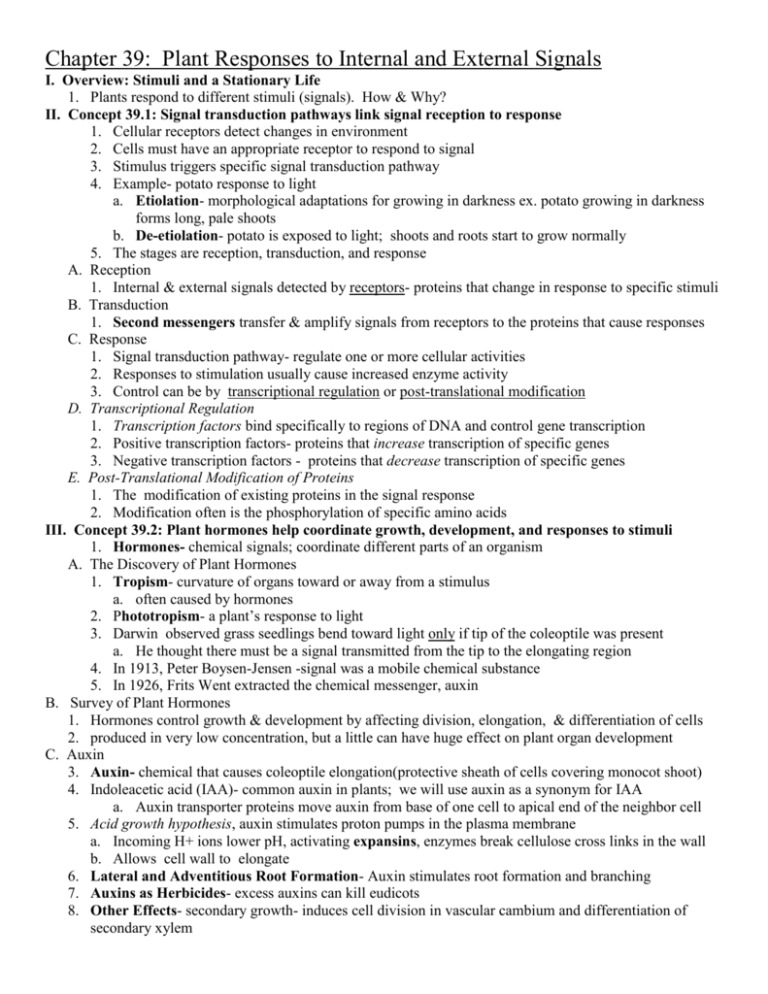
Chapter 39: Plant Responses to Internal and External Signals I. Overview: Stimuli and a Stationary Life 1. Plants respond to different stimuli (signals). How & Why? II. Concept 39.1: Signal transduction pathways link signal reception to response 1. Cellular receptors detect changes in environment 2. Cells must have an appropriate receptor to respond to signal 3. Stimulus triggers specific signal transduction pathway 4. Example- potato response to light a. Etiolation- morphological adaptations for growing in darkness ex. potato growing in darkness forms long, pale shoots b. De-etiolation- potato is exposed to light; shoots and roots start to grow normally 5. The stages are reception, transduction, and response A. Reception 1. Internal & external signals detected by receptors- proteins that change in response to specific stimuli B. Transduction 1. Second messengers transfer & amplify signals from receptors to the proteins that cause responses C. Response 1. Signal transduction pathway- regulate one or more cellular activities 2. Responses to stimulation usually cause increased enzyme activity 3. Control can be by transcriptional regulation or post-translational modification D. Transcriptional Regulation 1. Transcription factors bind specifically to regions of DNA and control gene transcription 2. Positive transcription factors- proteins that increase transcription of specific genes 3. Negative transcription factors - proteins that decrease transcription of specific genes E. Post-Translational Modification of Proteins 1. The modification of existing proteins in the signal response 2. Modification often is the phosphorylation of specific amino acids III. Concept 39.2: Plant hormones help coordinate growth, development, and responses to stimuli 1. Hormones- chemical signals; coordinate different parts of an organism A. The Discovery of Plant Hormones 1. Tropism- curvature of organs toward or away from a stimulus a. often caused by hormones 2. Phototropism- a plant’s response to light 3. Darwin observed grass seedlings bend toward light only if tip of the coleoptile was present a. He thought there must be a signal transmitted from the tip to the elongating region 4. In 1913, Peter Boysen-Jensen -signal was a mobile chemical substance 5. In 1926, Frits Went extracted the chemical messenger, auxin B. Survey of Plant Hormones 1. Hormones control growth & development by affecting division, elongation, & differentiation of cells 2. produced in very low concentration, but a little can have huge effect on plant organ development C. Auxin 3. Auxin- chemical that causes coleoptile elongation(protective sheath of cells covering monocot shoot) 4. Indoleacetic acid (IAA)- common auxin in plants; we will use auxin as a synonym for IAA a. Auxin transporter proteins move auxin from base of one cell to apical end of the neighbor cell 5. Acid growth hypothesis, auxin stimulates proton pumps in the plasma membrane a. Incoming H+ ions lower pH, activating expansins, enzymes break cellulose cross links in the wall b. Allows cell wall to elongate 6. Lateral and Adventitious Root Formation- Auxin stimulates root formation and branching 7. Auxins as Herbicides- excess auxins can kill eudicots 8. Other Effects- secondary growth- induces cell division in vascular cambium and differentiation of secondary xylem E. Cytokinins 1. Cytokinins- stimulate cytokinesis (cell division) 2. Control of Cell Division and Differentiation a. They work with auxin to control cell division and differentiation b. They are produced in actively growing tissues; roots, embryos, and fruits 3. Control of Apical Dominance a. Cytokinins, auxin, and other factors control apical dominance • apical dominance, a terminal bud’s ability to suppress development of axillary buds • Whenterminal bud is removed, plants become bushier 4. Anti-Aging Effects a. Cytokinins retard aging in plant organs • inhibit protein breakdown, • stimulate RNA and protein synthesis • mobilize nutrients from surrounding tissues F. Gibberellins 1. Gibberellins have a variety of effects, such as stem elongation, fruit growth, and seed germination 2. Stem Elongation a. stimulate growth of leaves and stems b. In stems-stimulate cell elongation and cell division 3. Fruit Growth- Gibberellins must be present for fruit to set 4. Germination- Causes seeds to germinate G. Brassinosteroids- chemically similar to animal sex hormones; Induce cell elongation and division in stems s H. Abscisic Acid 1. Abscisic acid (ABA) slows growth& has many other effects 2. Seed Dormancy- Seeds will germinate only in optimal conditions a. Dormancy is broken if ABA is removed- heavy rain, light, or prolonged cold b. Maize mutants lacking an ABA transcription factor fail to express certain genes & germinate early 3. Drought Tolerance- primary internal signal that enables plants to withstand drought I. Ethylene 1. Ethylene- produced in response to stress; ex drought, flooding, mechanical pressure, injury, & infection 2. Effects of ethylene include response to mechanical stress, senescence, leaf abscission, and fruit ripening 3. The Triple Response to Mechanical Stress a. Triple response allows a growing shoot to avoid obstacles b. Consists of slowing of stem elongation, thickening of the stem, and horizontal growth c. Ethylene-insensitive mutants don’t show triple response after exposure to ethylene 4. Senescence- the programmed death of plant cells or organs a. An ethylene burst causes apoptosis, the programmed destruction of cells, organs, or whole plants 5. Leaf Abscission- Changes in auxin/ethylene balance control leaf abscission-the release & fall of a leaf 6. Fruit Ripening- triggers the ripening process J. Systems Biology and Hormone Interactions a. Hormones and signal transduction pathways interact, the effects are hard to predict b. Systems biology seeks a comprehensive understanding that permits modeling of plant functions IV. Concept 39.3: Responses to light are critical for plant success 1. Plants detect light, its direction, intensity, and wavelength (color) 2. Photomorphogenesis- Effects of light on plant morphology 3. Action spectrum- a graph showing responses of various processes to different light wavelengths • useful in studying light dependant processes 4. There are two major classes of light receptors: blue-light photoreceptors and phytochromes A. Blue-Light Photoreceptors- control hypocotyl elongation, stomatal opening, and phototropism B. Phytochromes as Photoreceptors 1. Phytochromes are pigments that regulate many of a plant’s responses to light throughout its life 2. Responses include seed germination and shade avoidance 3. Phytochromes and Seed Germination a. Many seeds remain dormant until light conditions change b. Red light increase germination, while far-red light inhibits germination c. Phytochrome- photoreceptor that causes opposing effects of red and far-red light d. Phytochrome- two photoreversible states; Pr converts to Pfr: triggers many developmental responses 4. Phytochromes and Shade Avoidance a. Phytochrome system tells plants about quality of light; b. ex. Shaded plants get more far-red than red light c. In the “shade avoidance” response, the phytochrome ratio shifts in favor of Pr when a tree is shaded C. Biological Clocks and Circadian Rhythms 1. Many plant processes oscillate during the day 2. Many legumes lower their leaves in the evening and raise them in the morning, 3. Circadian rhythms are cycles that are about 24 hours long and are governed by an internal “clock” • Can be trained to exactly 24 hours by the day/night cycle • depends on synthesis of a protein regulated by feedback ; all eukaryotes may have it D. The Effect of Light on the Biological Clock 1. Phytochrome conversion marks sunrise and sunset, gives the biological clock environmental cues 2. Photoperiodism and Responses to Seasons a. Photoperiod, the relative lengths of night and day, is the environmental stimulus plants use most often to detect the time of year b. Photoperiodism is a physiological response to photoperiod 3. Photoperiodism and Control of Flowering a. Some processes, including flowering in many species, require a certain photoperiod b. short-day plants Plants that flower when a light period is shorter than a critical length c. long-day plants Plants flowering when a light period is longer than a certain number of hours d. Flowering in day-neutral plants is controlled by plant maturity, not photoperiod E. Critical Night Length 1. In the 1940s, found that flowering and other responses to photoperiod are controlled by night length 2. Short-day plants are governed by whether there are a minimum number of hours of darkness 3. Long-day plants are governed by whether night length sets a maximum number of hours of darkness 4. Red light can interrupt the nighttime portion of the photoperiod a. phytochrome is the pigment that receives red light b. Other factors may also influence flowering. c. vernalization is a pretreatment with cold to induce flowering F. A Flowering Hormone? 1. florigen flowering signal, still unidentified, is called florigen 2. Florigen may be governed by the CONSTANS gene 3. Meristem Transition and Flowering a. Meristem identity genes must be switched on for a bud to form a flower & not a vegetative shoot, b. Researchers seek to identify the signal transduction pathways that link cues such as photoperiod and hormonal changes to the gene expression required for flowering Concept 39.4: Plants respond to a wide variety of stimuli other than light 1. Because of immobility, plants must adjust to a range of environmental circumstances through developmental and physiological mechanisms A. Gravity 1. Response to gravity is known as gravitropism 2. Roots show positive gravitropism; shoots show negative gravitropism 3. Plants may detect gravity by the settling of statoliths, specialized plastids containing dense starch grains 4. Some mutants that lack statoliths are still capable of gravitropism 5. Dense organelles, in addition to starch granules, may contribute to gravity detection B. Mechanical Stimuli 1. Thigmomorphogenesis- changes in form that result from mechanical disturbance a. daily results in plants that are shorter than controls 2. Thigmotropism is growth in response to touch a. In vines and other climbing plants b. Rapid leaf movements in response to mechanical stimulation are examples of transmission of electrical impulses called action potentials C. Environmental Stresses 1. Environmental stresses can have adverse effects on survival, growth, and reproduction 2. Stresses can be abiotic (nonliving) or biotic (living) 3. Abiotic stresses include drought, flooding, salt stress, heat stress, and cold stress 4. Drought a. Plants reduce transpiration- close stomata, slow leaf growth, and reduce exposed surface area b. Growth of shallow roots is inhibited, while deeper roots continue to grow 5. Flooding a. Enzymes destroy root cortex cells to create air tubes- help plants survive oxygen deprivation 6. Salt Stress a. Salt can lower the water potential of the soil solution and reduce water uptake b. Plants respond to salt stress by producing solutes tolerated at high concentrations c. This process keeps the water potential of cells more negative than that of the soil solution 7. Heat Stress a. Excessive heat can denature a plant’s enzymes b. Heat-shock proteins help protect other proteins from heat stress 8. Cold Stress a. Cold temperatures decrease membrane fluidity b. Altering lipid composition of membranes is a response to cold stress c. Freezing causes ice to form in a plant’s cell walls and intercellular spaces Concept 39.5: Plants respond to attacks by herbivores and pathogens 1. Plants use defense systems to deter herbivory, prevent infection, and combat pathogens A. Defenses Against Herbivores 1. Herbivory, animals eating plants, is a stress common in any ecosystem 2. Counter herbivory with physical defenses like thorns & chemical defenses like bitter/ toxic compounds 3. Some plants even “recruit” predatory animals for defense 4. Plants damaged by insects release volatile chemicals to warn other plants of the same species 5. Methyljasmonic acid can activate the expression of genes involved in plant defenses B. Defenses Against Pathogens 1. first line of defense- the epidermis and periderm 2. Second line of defense is a chemical attack that kills the pathogen and prevents its spread 3. A virulent pathogen is one that a plant has little specific defense against 4. An avirulent pathogen is one that may harm but does not kill the host plant 5. Gene-for-gene recognition involves recognition of pathogen-derived molecules by protein products of specific plant disease resistance (R) genes a. An R protein recognizes a corresponding molecule made by the pathogen’s Avr gene b. R proteins activate plant defenses by triggering signal transduction pathways c. These defenses include the hypersensitive response and systemic acquired resistance C. The Hypersensitive Response 1. The hypersensitive response a. Causes cell and tissue death near the infection site b. Induces production of phytoalexins and PR proteins, which attack the pathogen c. Stimulates changes in the cell wall that confine the pathogen D. Systemic Acquired Resistance 1. Systemic acquired resistance- the systemic expression of defense genes; a long-lasting response 2. Salicylic acid is synthesized around the infection site and is likely the signal that triggers systemic acquired resistance
